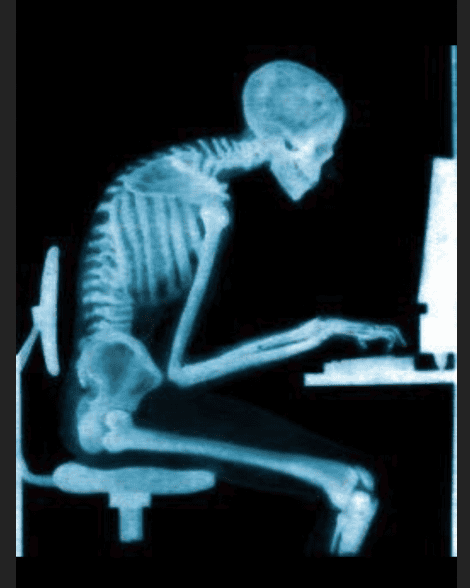I’m putting on my Massage Therapist hat today and going a little off topic. I want to discuss a topic that affects almost everyone I know: neck and shoulder pain associated with habitual computer use.
Many people dealing with this don’t realize that the computer is the source of their issue. Typically, I’ll have people speculate that it’s from exercise, or sleeping position, or an old injury, but more often than not it’s from spending 12+ hours a day hunched over in one position:
Or:
Chronic neck and shoulder pain has a pretty profound impact on quality of life. The BEST treatment, of course, is quitting your job and spending the rest of your life lounging on a tropical beach. If that’s not a feasible option, there are some things we can do to manage it.
Sleep
I’m discussing sleep first, because for the vast majority of people, simply getting adequate sleep will be the most beneficial change they can make. Adequate sleep allows the muscles to relax so the body can repair. Perhaps more importantly, inadequate sleep can compromise the serotonin system’s ability to support pain inhibition with natural opioids (1). Getting adequate sleep normalizes neuroendocrine function and supports homeostasis (2). There’s evidence that duration and quality of sleep can have a strong impact on the experience of pain (3). 7-8 hours a night of restful sleep seems to be ideal for most people, although some can get by with less and a few need more. We tend to dismiss the importance of sleep, but it’s probably one of the simplest and most profound changes we can make to improve our quality of life. William Dement has a fantastic book about the connection between sleep and pain (and other aspects of health): The Promise of Sleep: the Vital Connection Between Health, Happiness, and a Good Night’s Sleep
Exercise
Simply getting up out of your chair several times a day will bring relief! But there are specific exercises you can do as well. In a 2008 study, participants engaging in a simple strength training protocol experienced a 75% decrease in neck and shoulder pain over 10 weeks. The protocol involved 5 exercises, performed for 20 minutes 3 times a week. The exercises were the dumbbell shrug, bent over row, lateral raise, upright row and reverse fly. All of these can be done with light to moderate dumbbells or resistance bands. In fact, you can keep a set of dumbbells at your desk at work and do these exercises during down time, that’s how simple they are. Harvard Medical School has a great description of the study and the exercise protocol here.
Stretching
Take a few moments each day to give your neck and shoulder muscles a good stretch. The Mayo Clinic provides a few in this tutorial video, here are some more from E-How Health. If you’re looking for something more in depth, the Mayo Clinic created this guide to dealing with back pain for Gaiam. It includes exercises and stretching as well as nutrition and home care tips.
Massage
Studies show that massage can improve functionality and the experience of pain (4), at least in the short term. Massage won’t bring permanent relief unless you are able to stop doing that which is causing the pain (which is usually not realistic, as most of us must use computers in our jobs), but it will bring temporary relief, and regular massage can help manage the pain and stiffness from computer use. There are even self massage techniques you can utilize, and several very effective self massage tools, including the Thera Cane (my favorite) and Trigger Point Balls.
Ergonomics
Setting up your work station so that you are in a more natural position can be very helpful. If you habitually work on a laptop, use it at a table or desk rather than on your lap. UC Berkeley provides some simple tips for setting up an ergonomically correct workstation here. There are a wealth of products designed to create more ergonomically correct work stations, from tablet stands to ergonomic mice to lumbar support. You spend hours on end at this station, take some time to make sure it’s set up to minimize pain and stress on your body.
Most importantly, I think, is simple mindfullness. Our bodies don’t do well when we don’t move, so be aware of how long you’ve been sitting in one position and make an effort to increase your physical activity during the day. We spend a tremendous amount of time and energy thinking about what we eat and how we exercise, but something as simple as how we sit at our desks can have a really profound impact on our quality of life. It doesn’t take heroic measures to change though, just a few simple tweaks can make a huge difference. And as an added bonus, several of the things that I’ve discussed here not only improve neck and shoulder pain, they also improve overall health and support the maintenance of a healthy weight!



